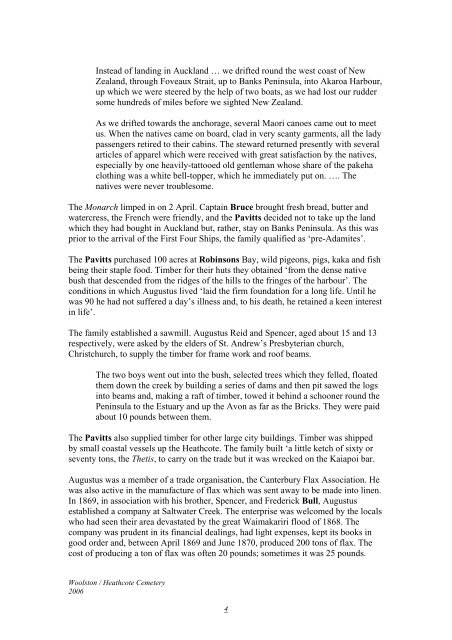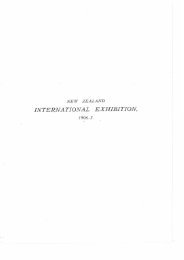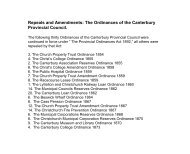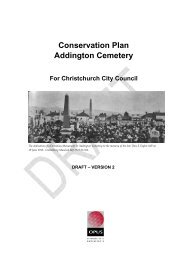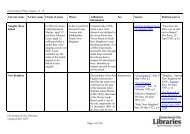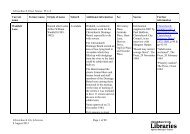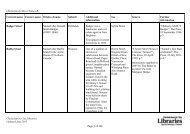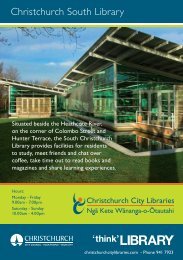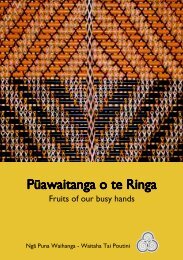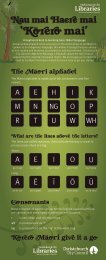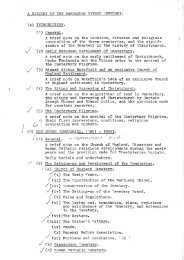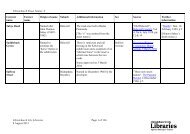Woolston / Heathcote Cemetery Tour - Christchurch City Libraries
Woolston / Heathcote Cemetery Tour - Christchurch City Libraries
Woolston / Heathcote Cemetery Tour - Christchurch City Libraries
You also want an ePaper? Increase the reach of your titles
YUMPU automatically turns print PDFs into web optimized ePapers that Google loves.
Instead of landing in Auckland … we drifted round the west coast of New<br />
Zealand, through Foveaux Strait, up to Banks Peninsula, into Akaroa Harbour,<br />
up which we were steered by the help of two boats, as we had lost our rudder<br />
some hundreds of miles before we sighted New Zealand.<br />
As we drifted towards the anchorage, several Maori canoes came out to meet<br />
us. When the natives came on board, clad in very scanty garments, all the lady<br />
passengers retired to their cabins. The steward returned presently with several<br />
articles of apparel which were received with great satisfaction by the natives,<br />
especially by one heavily-tattooed old gentleman whose share of the pakeha<br />
clothing was a white bell-topper, which he immediately put on. …. The<br />
natives were never troublesome.<br />
The Monarch limped in on 2 April. Captain Bruce brought fresh bread, butter and<br />
watercress, the French were friendly, and the Pavitts decided not to take up the land<br />
which they had bought in Auckland but, rather, stay on Banks Peninsula. As this was<br />
prior to the arrival of the First Four Ships, the family qualified as ‘pre-Adamites’.<br />
The Pavitts purchased 100 acres at Robinsons Bay, wild pigeons, pigs, kaka and fish<br />
being their staple food. Timber for their huts they obtained ‘from the dense native<br />
bush that descended from the ridges of the hills to the fringes of the harbour’. The<br />
conditions in which Augustus lived ‘laid the firm foundation for a long life. Until he<br />
was 90 he had not suffered a day’s illness and, to his death, he retained a keen interest<br />
in life’.<br />
The family established a sawmill. Augustus Reid and Spencer, aged about 15 and 13<br />
respectively, were asked by the elders of St. Andrew’s Presbyterian church,<br />
<strong>Christchurch</strong>, to supply the timber for frame work and roof beams.<br />
The two boys went out into the bush, selected trees which they felled, floated<br />
them down the creek by building a series of dams and then pit sawed the logs<br />
into beams and, making a raft of timber, towed it behind a schooner round the<br />
Peninsula to the Estuary and up the Avon as far as the Bricks. They were paid<br />
about 10 pounds between them.<br />
The Pavitts also supplied timber for other large city buildings. Timber was shipped<br />
by small coastal vessels up the <strong>Heathcote</strong>. The family built ‘a little ketch of sixty or<br />
seventy tons, the Thetis, to carry on the trade but it was wrecked on the Kaiapoi bar.<br />
Augustus was a member of a trade organisation, the Canterbury Flax Association. He<br />
was also active in the manufacture of flax which was sent away to be made into linen.<br />
In 1869, in association with his brother, Spencer, and Frederick Bull, Augustus<br />
established a company at Saltwater Creek. The enterprise was welcomed by the locals<br />
who had seen their area devastated by the great Waimakariri flood of 1868. The<br />
company was prudent in its financial dealings, had light expenses, kept its books in<br />
good order and, between April 1869 and June 1870, produced 200 tons of flax. The<br />
cost of producing a ton of flax was often 20 pounds; sometimes it was 25 pounds.<br />
<strong>Woolston</strong> / <strong>Heathcote</strong> <strong>Cemetery</strong><br />
2006<br />
4


